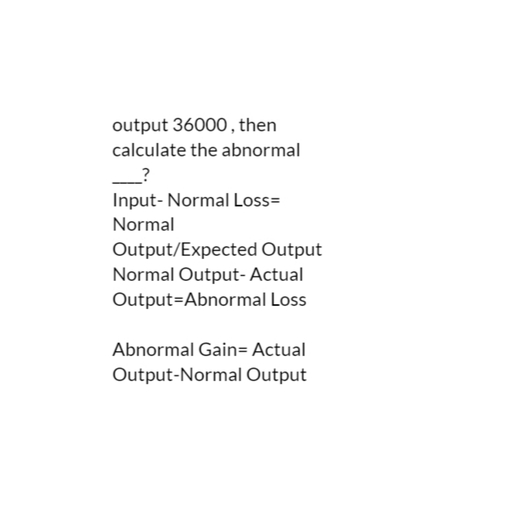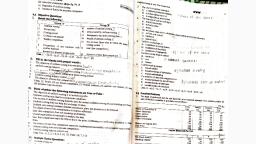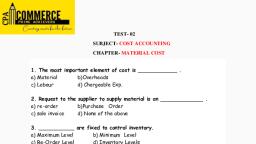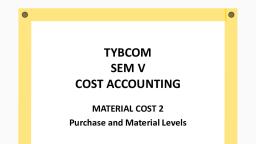Page 2 :
Costing of Material involves, , , Pricing of receipts, , , , Pricing of issues, , , , Stores ledger, , , , Ascertain material cost of individual job or, product
Page 3 :
Material Receipt Valuation, includes, Taxes, Duties, , Packing and, forwarding, , Transport, , Insurance, , Octroi, , Trade and Cash, Discount, (Deduct), , Receiving,, inspection, charges, , Storage, , Material, accounting, charges, , Cost of, containers, (Deduct of, returnable), , Import charges, , Basic Price
Page 4 :
Pricing Issues, , , Three main methods, • Cost price methods, , • Average Price Methods, • Notional Price Methods, , , Need of consistency, , , , Appropriate method should be selected
Page 5 :
Cost price methods, Specified price, FIFO – First in first out, , LIFO- Last in First out, HIFO- Highest in first out, Base Stock
Page 6 :
Average Price Methods, Simple Average, Weighted Average, , Periodic simple Average, Periodic Weighted Average, Moving Simple Average, Moving Weighted Average
Page 7 :
Notional Price Methods, Standard price, , Inflated price, , Market price
Page 8 :
Factors to be considered while, selection of method of pricing, of issues, , , Frequency of orders, , liability, , , , Price fluctuations, , , , Clerical Work involved, , , , Frequency of issues, , , , Costing System adopted, , , , Method of Stock valuation, , , , Traceability of issue to, , , , Stock turnover rate, , , , EOQ, , , , Effect of method on tax, , purchase lot, , , Nature of business
Page 9 :
FIFO (accepted by AS-2), , , This method assumes that inventory purchased or manufactured, first is sold first and newer inventory remains unsold., , , , Thus cost of older inventory is assigned to cost of goods sold, , and that of newer inventory is assigned to ending inventory., , , First-In, First-Out method can be applied in both the periodic, inventory system and the perpetual inventory system., , , , FIFO method is closer to actual physical flow of goods because, companies normally sell goods in order in which they are, , purchased or produced.
Page 10 :
FIFO, Advantages, , Disadvantages, , Simple in calculation and, application, , Cost is understated, , Logical, stock valued at current, price, , Cost of production is not linked, with the current prices, , Easy to understand, , Becomes complicated for returns, , Facilitates inter firm and intra firm, comparisons, , When issues are priced differently,, comparison becomes meaningless, , Price is based on actual cost and, not on estimated cost, Suitable when prices are falling, down and consumption rate is low
Page 11 :
Weighted Average Method, (accepted by AS-2), , , Under average cost method, weighted average cost per unit is calculated for, the entire inventory on hand which is used to record cost of goods sold., , , , Weighted average cost per unit is calculated as follows:, , , , Weighted Average Cost Per Unit= Total Cost, Total Units, , , , Weighted Average Cost Per Unit × number of units sold = cost of goods sold, , , , Weighted Average Cost Per Unit × number of units in closing Stock = Cost of, Closing Stock
Page 12 :
WAC, Advantages, , Disadvantages, , Logical and consistent, , Inconvenient and, complicated, , Value based on actual cost, , Not realistic as actual price is, not considered, , Less clerical work, , Involves more mathematical, work, , Profit are more realistic, Changes in price do not affect, issues and inventory
Page 13 :
Inventory systems, 1) Periodic System, 2) Perpetual Inventory System
Page 14 :
Periodic Inventory System, , , Inventory account is not updated for each purchase and each sale., , , , The closing inventory is computed at the end of the period by a, physical count., , , , This system is simple and less costly., , , , It doesn’t facilitate inventory control., , , , The general formula to compute cost of goods sold under periodic, inventory system is given below:, Cost of goods sold (COGS) = Opening Stock + Purchases – Closing, Stock
Page 15 :
Perpetual Inventory System, , , Provides a running balance of cost of goods available for sale and cost of, goods sold., , , , The accuracy of this balance is assured periodically by a physical count –, usually once a year., , , , Both trading and manufacturing companies use perpetual inventory system., , , , The inventory account is updated after each purchase and each sale., , , , The stock is valued at cost or NRV whichever is lower., , , , This system excludes obsolete stocks., , , , It is a costly method., , , , It facilitates inventory control.









































































